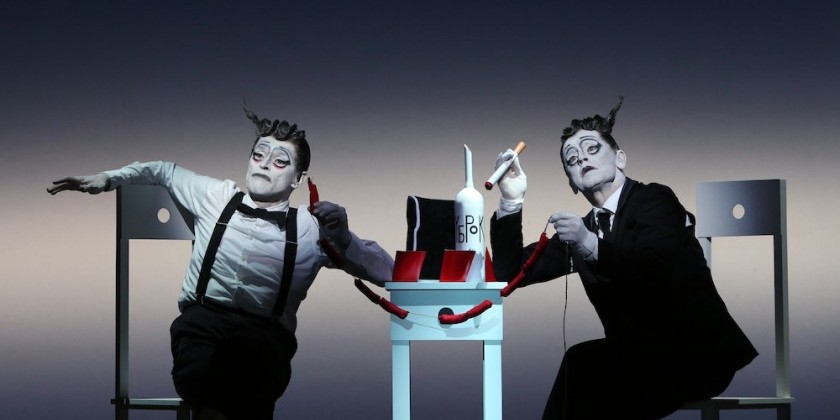Impressions From Paris: Robert Wilson's "The Old Woman" Starring Mikhail Baryshnikov and Willem Dafoe

after the work of Daniil Kharms at the Theatre de la Ville, Paris
The Old Woman
direction, design and lighting (conception) by Robert Wison
adaptation of Daniil Kharms' novella by Darryl Pinckney
performed by Michail Baryshnikov and Willem Dafoe
November 6-23, 2013
It is stellar. Mikhail Baryshnikov and Willem Dafoe come together in director/designer Robert Wilson's new work, The Old Woman, with stark and brutal brilliance. It is like watching a light so intense and unwavering that you end up swimming in darkness. It is like watching a black hole being born with your eyes wide open.
First comes the crash of thunder that bites at the nerves of the spine. There is no storm. Fluorescent strip lights pulse from the base of the stage. Then the two performers begin to move across the front of the proscenium like an old fashioned vaudeville act. Their movements are contained, restrained, precise. Ordinary movements (like 'shuffle ball change") are magnified. They feel explosive. One is asking the other what time it is, but the clock has no hands.

Baryshnikov and Dafoe are dressed identically: black suit, white shirt, bow tie, suspenders. Their faces are painted clown white with harsh black lines. They seem ancient in the harsh light. The only difference between them is the direction of the flight of their hair -- to the right, or off to the left. Between them they play all of the characters, including the 'Young Woman' at the bakery, and the 'Old Woman' who dies (in a magnificent minimalist distorted crown-like chair of white).
They switch roles each evening. Wilson says he sees them as both playing the same character: the author. It makes sense that we never really see an old woman since the writer, Daniil Kharms, was "interested in life only in its absurd manifestation". The Russian writer's novella has been adapted powerfully for the stage by Darryl Pinckney, with phrases that come at us again and again in English and sometimes Russian. The language is beautiful and cruel. Wilson delves into this domain with assurance. Everything is stamped out with a force, like a printing press that cuts through the paper.

Wilson's sets and lighting together leave a series of magnificent imprints: crisply distorted window frames float in space, radiant and glowing white against a rich turquoise scrim (surely it was one of these that the Old Woman who was too curious fell out of); a collapsed bed/shed seems a little like a wilting army tent; a white toy airplane advancing slowly turns into a glowing red projectile; a strip light train track (complete with harmonica wafting in the background) pulsates against our retinas; a glass swing hovers in timeless space, unmoving; a chain of sausages spirals upward like a cobra dancing in a basket -- a chain of DNA spiraling in space.
The work speaks of hunger. Hunger at the root of weakness, at the root of boredom, at the root of madness. What time is it?' Time to eat? Time to die? Time to make love? No -- that doesn't seem to be a real option, in spite of one moment of remarkable minimalist tenderness. "A drink at my place?" A well-aimed oversized cardboard gun fires. (Well, never mind that drink.)

There is a pre-occupation with with hunger (which makes sense when you learn that Kharms endured hunger and poverty much of his life) but the intellectual concept of hunger, not the sensation of hunger gnawing at the gut. Is it our hunger that drives us to the insanity of violence? What kind of hunger drives a person to even imagine kicking a dead person in the head? Because this happens here -- and it is thoroughly revolting, even in exaggerated mime.
I was disappointed with the movement, I have to admit. The vocabulary was restricted to the ordinary but turned up to such a pitch that, like music played too loud, we must retreat. My brain was allowed the space to float and function, but my senses were compressed and shattered. I became aware of being very cramped with my knees folded up against the seats in front of me, unable to move.
The work is repellent, and mean at heart -- sterile and sterilizing. Still, I would say that Robert Wilson has created a masterful and extra-ordinary interpretation of Kharms' writing.

By the time we get to the end -- after an old woman has fallen out of the window from too much curiosity; after another old woman has invaded the writer's apartment and died in his magisterial chair; after a dead body has been kicked in the head; after love has been shot at short range; after the breaking of the jaws of the man on the bench-- the text has looped over itself so many times, we can no longer tell who is speaking, Baryshnikov or Dafoe.
Perhaps it's the author's voice itself magnified through the speakers: "I used to be wise. I used to be able to kiss my foot… I was happy. I understood the happiness of others…" (But not anymore, it seems.) "Save me! Let me breathe!"
The work is undeniably and intentionally brilliant, but never before has sitting in the audience felt so much like imprisonment. I leave the theatre, and drink in the crisp autumn air, relieved and grateful to move again.











